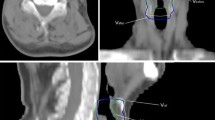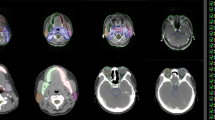Abstract
Target volume delineation in the radiation treatment of nasopharyngeal cancer is challenging due to several reasons such as the complex anatomy of the site, the need for the elective coverage of definite anatomical regions, the curative intent of treatment and the rarity of the disease, especially in non-endemic areas. We aimed to analyze the impact of educational interactive teaching courses on target volume delineation accuracy between Italian radiation oncology centers. Only one contour dataset per center was admitted. The educational course consisted in three parts: (1) The completely anonymized image dataset of a T4N1 nasopharyngeal cancer patient was shared between centers before the course with the request of target volume and organs at risk delineation; (2) the course was held online with dedicated multidisciplinary sessions on nasopharyngeal anatomy, nasopharyngeal cancer pattern of diffusion and on the description and explanation of international contouring guidelines. At the end of the course, the participating centers were asked to resubmit the contours with appropriate corrections; (3) the pre- and post-course contours were analyzed and quantitatively and qualitatively compared with the benchmark contours delineated by the panel of experts. The analysis of the 19 pre- and post-contours submitted by the participating centers revealed a significant improvement in the Dice similarity index in all the clinical target volumes (CTV1, CTV2 and CTV3) passing from 0.67, 0.51 and 0.48 to 0.69, 0.65 and 0.52, respectively. The organs at risk delineation was also improved. The qualitative analysis consisted in the evaluation of the inclusion of the proper anatomical regions in the target volumes; it was conducted following internationally validated guidelines of contouring for nasopharyngeal radiation treatment. All the sites were properly included in target volume delineation by >50% of the centers after correction. A significant improvement was registered for the skull base, the sphenoid sinus and the nodal levels. These results demonstrated the important role that educational courses with interactive sessions could have in such a challenging task as target volume delineation in modern radiation oncology.


Similar content being viewed by others
References
Sung H, Ferlay J, Siegel RL, Laversanne M, Soerjomataram I, Jemal A et al. (2021 ) Global cancer statistics 2020: GLOBOCAN estimates of incidence and mortality worldwide for 36 cancers in 185 countries. CA Cancer J Clin. 4 Feb 2021
Cancer today [Internet]. [cited 2022 Apr 4]. Available from: http://gco.iarc.fr/today/home
Pow EHN, Kwong DLW, McMillan AS, Wong MCM, Sham JST, Leung LHT, et al. (2006 ) Xerostomia and quality of life after intensity-modulated radiotherapy vs. conventional radiotherapy for early-stage nasopharyngeal carcinoma: initial report on a randomized controlled clinical trial. Int J Radiat Oncol Biol Phys 66(4):981–991
Zhang B, Mo Z, Du W, Wang Y, Liu L, Wei Y (2015) Intensity-modulated radiation therapy versus 2D-RT or 3D-CRT for the treatment of nasopharyngeal carcinoma: A systematic review and meta-analysis. Oral Oncol 51(11):1041–1046
McDowell LJ, Rock K, Xu W, Chan B, Waldron J, Lu L et al (2018) Long-term late toxicity, quality of life, and emotional distress in patients with nasopharyngeal carcinoma treated with intensity modulated radiation therapy. Int J Radiat Oncol Biol Phys 102(2):340–352
Stelmes JJ, Vu E, Grégoire V, Simon C, Clementel E, Kazmierska J et al (2021) Quality assurance of radiotherapy in the ongoing EORTC 1420 “Best of” trial for early stage oropharyngeal, supraglottic and hypopharyngeal carcinoma: results of the benchmark case procedure. Radiat Oncol Lond Engl 16(1):81
Zhong H, Men K, Wang J, van Soest J, Rosenthal D, Dekker A et al (2019) The impact of clinical trial quality assurance on outcome in head and neck radiotherapy treatment. Front Oncol 9:792
Vinod SK, Min M, Jameson MG, Holloway LC (2016) A review of interventions to reduce inter-observer variability in volume delineation in radiation oncology. J Med Imaging Radiat Oncol 60(3):393–406
Lee AW, Ng WT, Pan JJ, Poh SS, Ahn YC, AlHussain H et al (2018) International guideline for the delineation of the clinical target volumes (CTV) for nasopharyngeal carcinoma. Radiother Oncol J Eur Soc Ther Radiol Oncol 126(1):25–36
van Herk M (2004) Errors and margins in radiotherapy. Semin Radiat Oncol 14(1):52–64
Blanchard P, Gunn GB, Lin A, Foote RL, Lee NY, Frank SJ (2018) Proton therapy for head and neck cancers. Semin Radiat Oncol 28(1):53–63
Dubrulle F, Souillard R, Hermans R (2007) Extension patterns of nasopharyngeal carcinoma. Eur Radiol 17(10):2622–2630
Tsai WL, Huang TL, Liao KC, Chuang HC, Lin YT, Lee TF et al (2014) Impact of late toxicities on quality of life for survivors of nasopharyngeal carcinoma. BMC Cancer 21(14):856
Corry J, Ng WT, Moore A, Choi HCW, Le Q, Holmes S et al (2021) Can radiation therapy quality assurance improve nasopharyngeal cancer outcomes in low- and middle-income countries: reporting the first phase of a prospective international atomic energy agency study. Int J Radiat Oncol Biol Phys 111(5):1227–1236
Bekelman JE, Wolden S, Lee N (2009) Head-and-neck target delineation among radiation oncology residents after a teaching intervention: a prospective, blinded pilot study. Int J Radiat Oncol Biol Phys 73(2):416–423
Szumacher E, Harnett N, Warner S, Kelly V, Danjoux C, Barker R et al (2010) Effectiveness of educational intervention on the congruence of prostate and rectal contouring as compared with a gold standard in three-dimensional radiotherapy for prostate. Int J Radiat Oncol Biol Phys 76(2):379–385
Wong EK, Truong PT, Kader HA, Nichol AM, Salter L, Petersen R et al (2006) Consistency in seroma contouring for partial breast radiotherapy: impact of guidelines. Int J Radiat Oncol Biol Phys 66(2):372–376
Chen L, Liu LZ, Mao YP, Tang LL, Sun Y, Chen Y et al (2011) Grading of MRI-detected skull-base invasion in nasopharyngeal carcinoma and its prognostic value. Head Neck 33(9):1309–1314
Biau J, Dunet V, Lapeyre M, Simon C, Ozsahin M, Grégoire V et al (2019) Practical clinical guidelines for contouring the trigeminal nerve (V) and its branches in head and neck cancers. Radiother Oncol J Eur Soc Ther Radiol Oncol 131:192–201
Chiu K, Hoskin P, Gupta A, Butt R, Terparia S, Codd L et al (2022) The quantitative impact of joint peer review with a specialist radiologist in head and neck cancer radiotherapy planning. Br J Radiol 95(1130):20211219
Tonoli S, Alterio D, Caspiani O, Bacigalupo A, Bunkheila F, Cianciulli M et al (2016) Nasopharyngeal carcinoma in a low incidence European area : a prospective observational analysis from the Head and Neck Study Group of the Italian Society of Radiation Oncology (AIRO). Strahlenther Onkol Organ Dtsch Rontgengesellschaft Al 192(12):931–943
Feng M, Wang W, Fan Z, Fu B, Li J, Zhang S et al (2013) Tumor volume is an independent prognostic indicator of local control in nasopharyngeal carcinoma patients treated with intensity-modulated radiotherapy. Radiat Oncol Lond Engl 5(8):208
Ng WT, Lee MCH, Chang ATY, Chan OSH, Chan LLK, Cheung FY et al (2014) The impact of dosimetric inadequacy on treatment outcome of nasopharyngeal carcinoma with IMRT. Oral Oncol 50(5):506–512
Iacovelli NA, Cicchetti A, Cavallo A, Alfieri S, Locati L, Ivaldi E et al (2020) Role of IMRT/VMAT-Based Dose and Volume Parameters in Predicting 5-Year Local Control and Survival in Nasopharyngeal Cancer Patients. Front Oncol 10:518110
Lin L, Dou Q, Jin YM, Zhou GQ, Tang YQ, Chen WL et al (2019) Deep learning for automated contouring of primary tumor volumes by mri for nasopharyngeal carcinoma. Radiology 291(3):677–686
Hansen CR, Johansen J, Samsøe E, Andersen E, Petersen JBB, Jensen K et al (2018) Consequences of introducing geometric GTV to CTV margin expansion in DAHANCA contouring guidelines for head and neck radiotherapy. Radiother Oncol J Eur Soc Ther Radiol Oncol 126(1):43–47
Grégoire V, Evans M, Le QT, Bourhis J, Budach V, Chen A et al (2018) Delineation of the primary tumour Clinical Target Volumes (CTV-P) in laryngeal, hypopharyngeal, oropharyngeal and oral cavity squamous cell carcinoma: AIRO, CACA, DAHANCA, EORTC, GEORCC, GORTEC, HKNPCSG, HNCIG, IAG-KHT, LPRHHT, NCIC CTG, NCRI, NRG Oncology, PHNS, SBRT, SOMERA, SRO, SSHNO, TROG consensus guidelines. Radiother Oncol J Eur Soc Ther Radiol Oncol 126(1):3–24
Corso di formazione a distanza sul Contouring delle neoplasie dell’ipofaringe—Brescia—9–10 Luglio 2020 » Associazione Italiana di Radioterapia ed Oncologia Clinica [Internet]. Associazione Italiana di Radioterapia ed Oncologia Clinica. [cited 2022 Jul 20]. Available from: https://www.radioterapiaitalia.it/evento/corso-di-contouring-delle-neoplasie-dellipofaringe-brescia-9-10-luglio-2020/
Li WF, Sun Y, Chen M, Tang LL, Liu LZ, Mao YP et al (2012) Locoregional extension patterns of nasopharyngeal carcinoma and suggestions for clinical target volume delineation. Chin J Cancer 31(12):579–587
Lin L, Lu Y, Wang XJ, Chen H, Yu S, Tian J et al (2018) Delineation of neck clinical target volume specific to nasopharyngeal carcinoma based on lymph node distribution and the international consensus guidelines. Int J Radiat Oncol Biol Phys 100(4):891–902
Lee AW, Poon YF, Foo W, Law SC, Cheung FK, Chan DK et al (1992) Retrospective analysis of 5037 patients with nasopharyngeal carcinoma treated during 1976–1985: overall survival and patterns of failure. Int J Radiat Oncol Biol Phys 23(2):261–270
Fairchild A, Langendijk JA, Nuyts S, Scrase C, Tomsej M, Schuring D et al (2014) Quality assurance for the EORTC 22071–26071 study: dummy run prospective analysis. Radiat Oncol Lond Engl 26(9):248
Peng YL, Chen L, Shen GZ, Li YN, Yao JJ, Xiao WW et al (2018Jul) Interobserver variations in the delineation of target volumes and organs at risk and their impact on dose distribution in intensity-modulated radiation therapy for nasopharyngeal carcinoma. Oral Oncol 82:1–7
Tao CJ, Yi JL, Chen NY, Ren W, Cheng J, Tung S et al (2015) Multi-subject atlas-based auto-segmentation reduces interobserver variation and improves dosimetric parameter consistency for organs at risk in nasopharyngeal carcinoma: a multi-institution clinical study. Radiother Oncol J Eur Soc Ther Radiol Oncol 115(3):407–411
van Dijk LV, Van den Bosch L, Aljabar P, Peressutti D, Both S, J H M Steenbakkers R et al. (2020) Improving automatic delineation for head and neck organs at risk by deep learning contouring. Radiother Oncol J Eur Soc Ther Radiol Oncol 142:115–123
Acknowledgements
The Authors thank the Scientific Committee and Board of the AIRO for the critical revision and final approval of the manuscript
Funding
This research received no funding.
Author information
Authors and Affiliations
Contributions
Conceptualization was contributed by FD, ADR, AE and GI; software was contributed by FD, GI; data curation was contributed by all authors; writing—original draft preparation, was contributed by FD, ADR, AE and GI; supervision was contributed by FD, AM, DA, EO, DM and GS; writing, reviewing and editing, was contributed by all authors.
Corresponding author
Ethics declarations
Conflict of interest
The authors declare no conflict of interest.
Ethical standards
The study was conducted according to the guidelines of the Declaration of Helsinki. All the patient data were completely anonymized: The patient gave written informed consent for the study. The study was notified to and approved by the Institutional Review Board of the IRCCS Regina Elena Cancer Institute, protocol 15202 n.1792/22.
Additional information
Publisher's Note
Springer Nature remains neutral with regard to jurisdictional claims in published maps and institutional affiliations.
Rights and permissions
Springer Nature or its licensor (e.g. a society or other partner) holds exclusive rights to this article under a publishing agreement with the author(s) or other rightsholder(s); author self-archiving of the accepted manuscript version of this article is solely governed by the terms of such publishing agreement and applicable law.
About this article
Cite this article
Dionisi, F., Di Rito, A., Errico, A. et al. Nasopharyngeal cancer: the impact of guidelines and teaching on radiation target volume delineation. Radiol med 128, 362–371 (2023). https://doi.org/10.1007/s11547-023-01612-x
Received:
Accepted:
Published:
Issue Date:
DOI: https://doi.org/10.1007/s11547-023-01612-x




